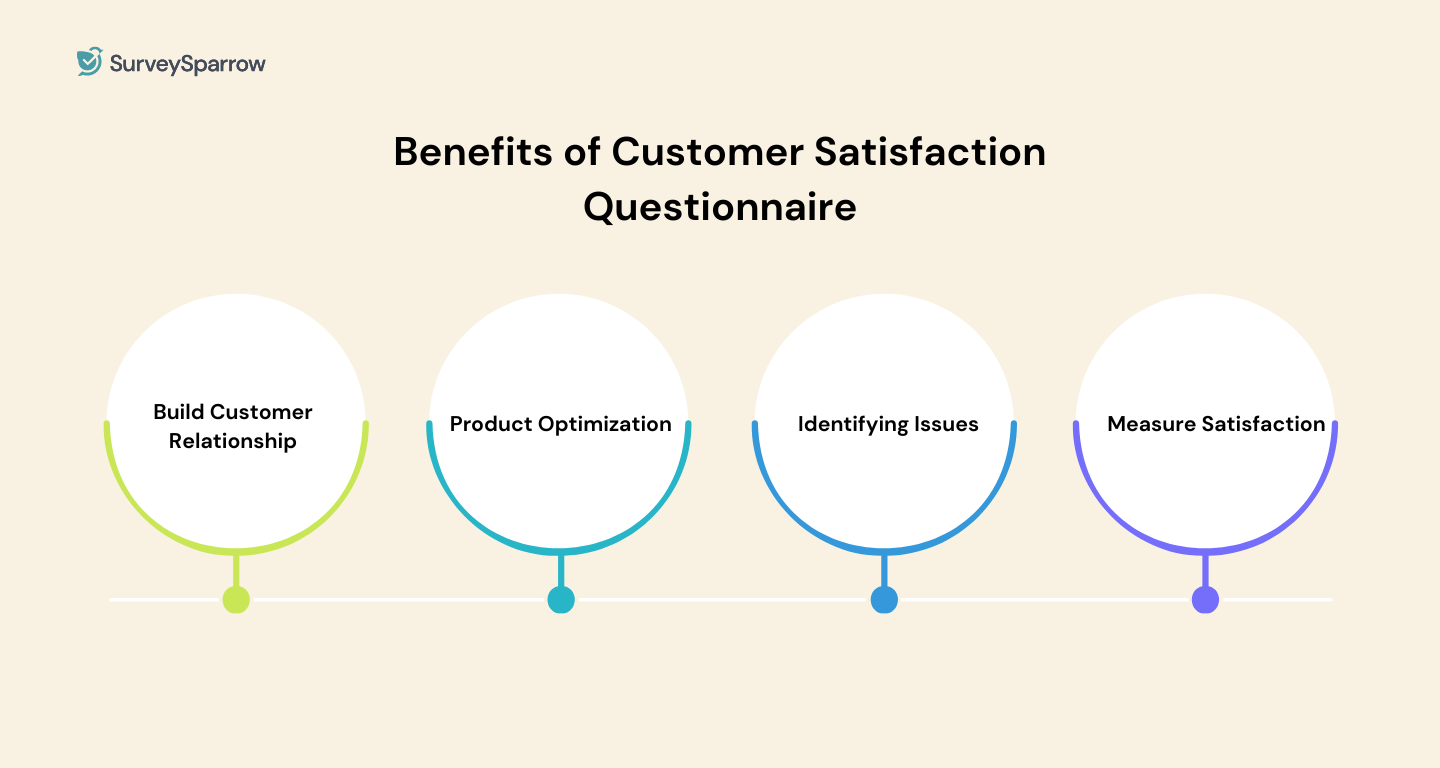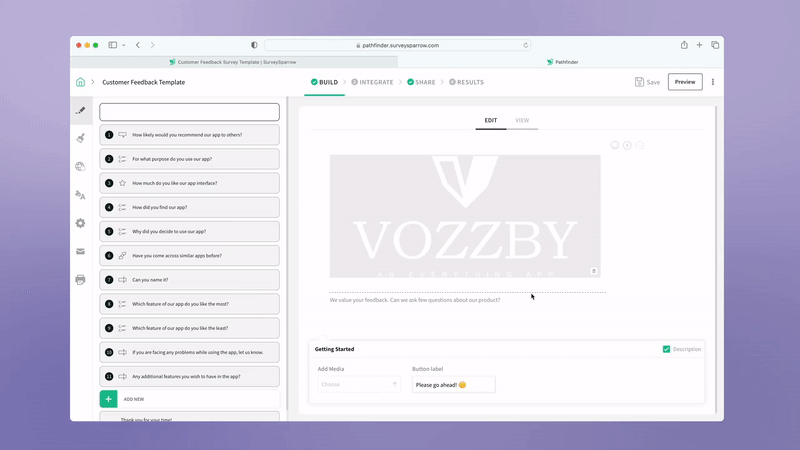Best Of
15 Must-Ask Customer Satisfaction Questions With Examples
Article written by Kate Williams
Product Marketing Manager at SurveySparrow
15 min read
21 November 2024

Satisfied customers prefer to stay with the brand, implying better retention and increased repeat business. This alone is emphasizes the importance of having satisfied customers. One of the best ways to measure this is by using structured customer satisfaction questionnaires.
In fact, a recent study showed that 78% of customers return if they are satisfied with the experience. All the more reason to ensure customer satisfaction.
Read on as we discuss everything about customer satisfaction survey questions, the different questionnaires, and more.
Jump to your desired section.
- Types of customer satisfaction survey questions
- 15 Customer satisfaction survey questions
- Customer satisfaction questionnaire templates
- Importance of customer satisfaction questionnaires
- Create customer satisfaction questionnaires with SurveySparrow
Let’s start by understanding what they are.
What are Customer Satisfaction Questionnaires?
Customer satisfaction questionnaires are a set of questions to measure customer satisfaction.
These questions are strategically structured and designed to collect feedback on experiences, services, interactions, and a brand’s overall outlook.
But again, it is so much more than just questions. They help you understand customer perception, improve products and services, enhance customer loyalty, and boost retention.
They can be categorized based on the specific areas you want to measure. And, most importantly - Time it right!
5 Types of Customer Satisfaction Survey Questions
The following are six main types of survey questions you should ask in a customer satisfaction survey. Let's have a look at it.
1. Net Promoter Score (NPS) Questions

NPS questions measure how likely customers are to recommend your product or service to others on a scale of 0 to 10. The main purpose of using this question is to assess your customers' loyalty and satisfaction levels.
Furthermore, depending on the score provided by the customers can be differentiated into three categories. They are promoters, detractors, and passives.
Question Example: "On a scale of 0-10, How likely are you to recommend us to a friend or colleague?"
When to use it? After major customer interactions, product/service purchases, or quarterly reviews.
2. Overall Customer Satisfaction Questions

These questions evaluate a customer’s general happiness with your product or service on a scale or in descriptive terms. They are useful for calculating average CSAT scores and identifying trends.
Question Example: "How satisfied are you with the competency of our customer support?"
When to use it? After a purchase or interaction to gauge immediate satisfaction.
3. Open-Ended Questions

These questions allow customers to share feedback in their own words, offering detailed and personalized insights. You can use these to get unfiltered customer opinions, which are more detailed and specific.
Question Example: "If there was one new feature you could suggest, what would it be and why?"
When to use it? To gather suggestions, identify pain points, or explore customer expectations.
4. Yes or No Questions

These binary questions give customers a simple choice to express agreement, satisfaction, or confirmation.
Question Example: "Did our product meet your expectations?"
When to use it? When you need clear, actionable answers to specific questions.
5. Multiple Choice Questions

MCQ questions offer predefined options for customers to choose from. This way it will be easier for categorization of feedback.
Question Example: "What was the main reason for your visit today?"
- Product Purchase
- Service Inquiry
- General Information
- Other
When to use it? When you want structured feedback on specific topics like reasons for dissatisfaction or feature preferences.
If you are having trouble coming up with structured survey questions, may we suggest SurveySparrow AI. Simply add in the prompt, and the tool will take care of the rest. Here's a sneak peek into its functioning.

The feature is available with the free version, so feel free to try it out.

15 Must-Ask Customer Satisfaction Survey Questions
The following 15 must-ask questions you should include in your customer satisfaction surveys.
1. How satisfied are you with your experience?
As you can see, this question is designed to measure your overall satisfaction. The score provides a clear and concise snapshot of how the customer feels about their experience. Thus, it makes it easier to track trends and patterns.
When to Ask?
The ideal time to ask this is immediately after a key interaction such as right after completing a purchase. This way the experience is still fresh in the minds of customers.
If any case happens where a customer repeatedly provides a score of 6, you can assess the recurring pain point and resolve it.
2. On a scale of 0-10, how likely are you to recommend our product/service to a friend or colleague? (NPS)
We all know NPS questions, right? If you don't, it's the one that assesses your customers' loyalty. Depending on the score provided to you, the customers can be differentiated into -
- Promoters
- Passives
- Detractors
When to Ask?
We suggest asking this question after a major milestone, such as fully completing a service. Try not to be premature. Be patient and make sure the customers have enough experience to provide an informed answer.
A high NPS score suggests strong loyalty, which often correlates with repeat business and referrals. So, always strive towards that.
3. What did you like most about our product/service?
These are usually open-ended questions to collect customer perspectives about your product/service. Such detailed feedback can provide deeper insights into why customers like it.
When to Ask?
Preferably after a positive interaction or successful purchase. This way, the customers are likely to be reflective and appreciative. For instance, if a customer consistently mentions fast shipping as a highlight, emphasize it for branding.
NOTE: Knowing what resonates with your customers can significantly help with your marketing efforts. By highlighting the aspects that customers love, you can optimize marketing campaigns and sales pitches.

4. What could we improve about our product/service?
Again, it's an open-ended question, but this time, it's for constrictive criticism. The question entertains customers to pinpoint areas that need improvement.
When to Ask?
These are mostly asked towards the end of a survey or feedback session. By working on the concerns shared by the customers, you can improve overall satisfaction.
For example, suppose multiple customers suggest clearer instructions for product assembly. Then, you can work on it by providing proper user guides or creating instructional videos.
5. Did our product/service meet your expectations?
Why or why not? Meeting customer expectations is like the best thing that could happen to a product. This is why asking these types of questions is important. If you didn't know - meeting expectations would mean satisfied customers.
When to Ask?
Preferably after the customer has used your product or service for a reasonable period. This way, it allows them to evaluate its performance.
6. How satisfied were you with the resolution of your issue?
If you want to learn how effective your resolution has been, then ask your customers this question. This question assesses how effective and satisfied customers are with the support you provide.
When to Ask?
The best time to ask is immediately after resolving a customer query or issue. The key is to collect information when it is still fresh in their mind.
7. Was it easy to find what you were looking for?
This question evaluates the usability of your platform or website. The primary focus will be on the ease of navigation and access to information. The answer to this question helps you identify usability issues that may be causing frustration.
When to Ask?
In the case of e-commerce stores, it's best to ask, after a browsing session, whether or not it resulted in a purchase. Or after the customer interacts with a feature like search.
8. What made you choose us over competitors?
If you want to get a competitive advantage, you have to know what unique things are you offering. This way, you can understand the exact reason why customers prefer your brand. Leveraging this, you can refine your USP and focus on what sets you apart in the market.
When to Ask?
Ideally, after a purchase or during a loyalty survey to capture reflective insights.
9. Was our pricing fair for the value provided?
Pricing is a key factor that customers look into before purchasing. This question evaluates customer perceptions of value-for-money. Like if customers frequently indicate pricing is too high, then consider adjusting it or provide insights to justify it.
When to Ask?
We suggest asking right after a purchase. This ensures that customers have had time to assess the product or service.
10. Do you feel we value your business?
Ask this question to measure the emotional connection and whether customers feel appreciated. Undervalued customers often seek out brands that provide better offerings.
When to Ask?
The best time to ask is during major milestones in the customer lifecycle. For instance, after a major purchase or on the anniversary of becoming a customer.
11. Do you have any additional feedback for us?
These are those types of survey questions that we can use to collect insights that may not be covered by structured questions. Open-ended questions are suitable here because they offer customers the freedom to express their thoughts.
When to Ask?
At the end of any survey, allow customers to share unique thoughts.
12. Did our product/service solve your problem?
This question isn’t just about metrics, it’s about understanding whether you’ve made a real difference in someone’s life. Did you ease a frustration, solve a challenge, or provide relief? This feedback can be transformative for shaping your offerings.
When to Ask?
Ask this question after customers have had time to use your product or service, like following a support interaction or after the end of a trial period. By asking when emotions are still fresh, you can gather honest, meaningful insights.
13. What stopped you from completing your purchase?
This question gets to the heart of hesitation. Was it confusion, frustration, or something external? Understanding this moment of friction can reveal untapped opportunities to guide potential customers toward confidence and trust.
When to Ask?
Ideally, ask immediately after a cart is abandoned or when someone exits your site without completing a purchase. Timing matters. Catch them before they forget what held them back.
Imagine someone responds, “I wasn’t sure if the product would fit my needs.” That’s your sign to improve product descriptions or add a live chat feature.
14. How would you rate your interaction with our team?
This question is about the personal connections your team creates. Did your customers feel heard, valued, and respected? Great customer service isn’t just functional, it’s about leaving people with a positive emotional experience.
When to Ask?
Ask right after the interaction - whether it’s with support, sales, or anyone else. Timing is everything when it comes to capturing how someone felt about their experience.
15. How did you hear about us?
This isn’t just a data point. Rather it’s the beginning of your story with a customer. Did a friend rave about you? Did they stumble upon you while scrolling Instagram at midnight? Knowing this helps you refine your message to show up where it matters most.
When to Ask?
Slip this question in during sign-ups, purchases, or welcome surveys when your customer is just starting to interact with you. It sets the tone for how you communicate going forward.
If someone shares, “I saw an influencer use your product, and it seemed authentic,” it’s your sign to double down on influencer collaborations.

Create Customer Satisfaction Surveys Faster and Better with AI!
A personalized walkthrough by our experts. No strings attached!
Customer Satisfaction Questionnaire Templates
For those who want to get ready-to-use templates for your satisfaction surveys, here are some from the SurveySparrow template library.
Each one is designed for a specific need, so you get the most useful insights.
1. General Customer Satisfaction Survey Template
Who can use this? Any business, big or small, like shops, online stores, hotels, or service providers.
When to use this? After a customer makes a purchase, gets help from support, or visits your website. You can also use it regularly, like every three or six months, to track satisfaction.
General Customer Satisfaction Survey
Use This TemplateThis template helps you measure how happy your customers are with your business. It covers questions about their overall experience, what they like, and what you can do better. Use this to improve customer loyalty and service quality.
2. Restaurant Customer Feedback Template
Who can use this? Restaurants, cafes, food delivery services, and food trucks.
When to use this? After a customer dines in, orders delivery, or attends an event at your restaurant.
Restaurant Customer Feedback Survey
Use This TemplateThis template is great for getting feedback about your restaurant. It asks about food quality, service, and atmosphere so you can see what your customers love and what needs improvement.
3. Product Satisfaction Survey Template
Who can use this? Product teams, marketers, or anyone responsible for creating or improving products.
When to use this? After launching a new product, during testing, or when planning updates.
Product Satisfaction Survey
Use This TemplateIf you’re launching a new product or want to improve an existing one, this template can help. It includes questions about how easy the product is to use, its features, and whether customers think it’s worth the price.
4. Client Satisfaction Survey Template
Who can use this? Agencies, consultants, and any business that provides services to other businesses.
When to use this? After finishing a project, at key milestones, or during regular check-ins with clients.
Client Satisfaction Survey
Use This TemplateThis template helps you understand how happy your clients are with your services. It includes questions about your communication, the results you delivered, and how you can do better.
5. Vendor Satisfaction Survey Template
Who can use this? Businesses that work with suppliers, contractors, or other partners.
When to use this? After completing a project, during regular vendor reviews, or before renewing contracts.
Vendor Satisfaction Survey
Use This TemplateUse this template to see how well your vendors are performing. It asks about things like on-time delivery, quality of products or services, and communication.
Importance of Customer Satisfaction Questionnaires
Let’s get into the purpose of rolling out these surveys. They help in:

1. Building Customer Relationship
When you show that you give customers the value they deserve or more, they see that their feedback matters. This builds a sense of trust and belonging.
Moreover, the feedback from these questionnaires will provide detailed insights into customer sentiments and emotions.
2. Product Optimization
The feedback you get will give you a comprehensive view of where your product/service/brand stands in the market. These insights will help you improve the product and provide better services that enhance CX.
3. Identifying Issues
Just as we get that inside view of areas for improvement, the information you gather will let you forecast potential issues. By identifying them, you can take fast measures to tackle and solve them! A bug-free experience is all that matters!
4. Measure Satisfaction
The most obvious is that these questionnaires are built solely to measure customer satisfaction. The reasons mentioned above are add-ons.
With a CSAT questionnaire, you can reach the core of customer experience and provide a structured framework.
Now, it’s time to look at a few questions.
How to Craft Engaging Customer Satisfaction Questionnaires with SurveySparrow
Crafting a questionnaire is pretty much an art that requires precision and patience. But with tools like SurveySparrow, the art and the artist merge with elegance.
Too poetic, huh? This is the language I suggested you avoid a second back!
Now, let me walk you through how we do it here at SurveySparrow! Working your way through a template is the best way to learn!
Step 1: Sign in
Log in to your SurveySparrow account.
If you don’t have one, don’t worry. Get started with a free version.
A personalized walkthrough by our experts. No strings attached!
Step 2: Create
What are you planning to work with? Do you wish to create something yourself or use a template?
- If you wish to work your way up from scratch, click the +New Survey and start.
- If it is a pre-designed template you wish to customize, Click on Browse Classic Templates and search for the one you want.
You can also choose to customize the free template I have attached above.
Step 3: Customize
Now is the time to create a conversational questionnaire! Have your way around the template.
Here’s how you do it:

- You can remove the questions that don’t fit the bill.
- Add new ones from the list we discussed.
- Edit the existing ones with the help of the “wing feature.” You can compress, expand, rephrase, reword, and edit it to your heart’s desire!
Next up, it’s time to…
Step 4: Integrate
Connect with your favorite apps and get a smooth workflow. The list includes popular platforms such as Mailchimp, Salesforce, Zapier, and Hubspot.
Step 5: Share
That’s it. You have your customer satisfaction questionnaire ready to be shared.
You can reach your audience via email, WhatsApp, SMS, social media, QR code, or by embedding the survey on your webpage.
Isn’t that easy?
Well, it doesn’t stop there. With SurveySparrow’s latest Text Analytics Tool- Cognivue, advanced decoding of customer sentiments is not a far-fetched dream.
You can conduct a root cause analysis, verify hidden insights, and segment customer sentiments based on mentions, count, and sentiment score. Oh, I forgot to tell you, all this is AI-powered, and you need to move a finger to get those numbers!
Why don’t you take the platform for a spin today?
A personalized walkthrough by our experts. No strings attached!
Start 14 Days free trial

Kate Williams
Excels in empowering visionary companies through storytelling and strategic go-to-market planning. With extensive experience in product marketing and customer experience management, she is an accomplished author, podcast host, and mentor, sharing her expertise across diverse platforms and audiences.
Related Articles

Best Of
Difference Between Appraisal Letter & Appreciation Letter
12 MINUTES
3 January 2021

Best Of
How to Use Employee Net Promoter Score To Drive Culture
14 MINUTES
13 January 2021

Brand Experience
Product Naming Strategies: Mastering The Art Of Naming A Product
12 MINUTES
8 September 2023

Customer Experience
How to Improve Customer Experience? Here’re 8 Surefire Ways!
9 MINUTES
4 April 2018
